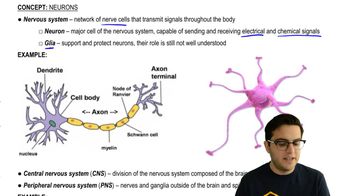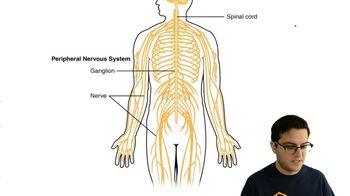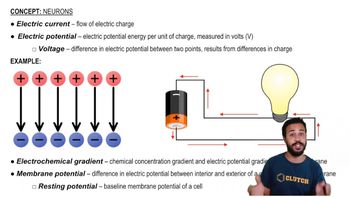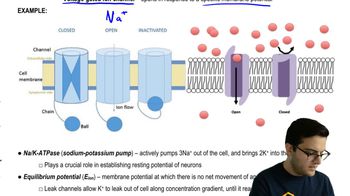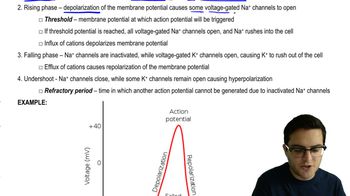Table of contents
- 1. Introduction to Biology2h 42m
- 2. Chemistry3h 40m
- 3. Water1h 26m
- 4. Biomolecules2h 23m
- 5. Cell Components2h 26m
- 6. The Membrane2h 31m
- 7. Energy and Metabolism2h 0m
- 8. Respiration2h 40m
- 9. Photosynthesis2h 49m
- 10. Cell Signaling59m
- 11. Cell Division2h 47m
- 12. Meiosis2h 0m
- 13. Mendelian Genetics4h 44m
- Introduction to Mendel's Experiments7m
- Genotype vs. Phenotype17m
- Punnett Squares13m
- Mendel's Experiments26m
- Mendel's Laws18m
- Monohybrid Crosses19m
- Test Crosses14m
- Dihybrid Crosses20m
- Punnett Square Probability26m
- Incomplete Dominance vs. Codominance20m
- Epistasis7m
- Non-Mendelian Genetics12m
- Pedigrees6m
- Autosomal Inheritance21m
- Sex-Linked Inheritance43m
- X-Inactivation9m
- 14. DNA Synthesis2h 27m
- 15. Gene Expression3h 20m
- 16. Regulation of Expression3h 31m
- Introduction to Regulation of Gene Expression13m
- Prokaryotic Gene Regulation via Operons27m
- The Lac Operon21m
- Glucose's Impact on Lac Operon25m
- The Trp Operon20m
- Review of the Lac Operon & Trp Operon11m
- Introduction to Eukaryotic Gene Regulation9m
- Eukaryotic Chromatin Modifications16m
- Eukaryotic Transcriptional Control22m
- Eukaryotic Post-Transcriptional Regulation28m
- Eukaryotic Post-Translational Regulation13m
- 17. Viruses37m
- 18. Biotechnology2h 58m
- 19. Genomics17m
- 20. Development1h 5m
- 21. Evolution3h 1m
- 22. Evolution of Populations3h 52m
- 23. Speciation1h 37m
- 24. History of Life on Earth2h 6m
- 25. Phylogeny2h 31m
- 26. Prokaryotes4h 59m
- 27. Protists1h 12m
- 28. Plants1h 22m
- 29. Fungi36m
- 30. Overview of Animals34m
- 31. Invertebrates1h 2m
- 32. Vertebrates50m
- 33. Plant Anatomy1h 3m
- 34. Vascular Plant Transport1h 2m
- 35. Soil37m
- 36. Plant Reproduction47m
- 37. Plant Sensation and Response1h 9m
- 38. Animal Form and Function1h 19m
- 39. Digestive System1h 10m
- 40. Circulatory System1h 57m
- 41. Immune System1h 12m
- 42. Osmoregulation and Excretion50m
- 43. Endocrine System1h 4m
- 44. Animal Reproduction1h 2m
- 45. Nervous System1h 55m
- 46. Sensory Systems46m
- 47. Muscle Systems23m
- 48. Ecology3h 11m
- Introduction to Ecology20m
- Biogeography14m
- Earth's Climate Patterns50m
- Introduction to Terrestrial Biomes10m
- Terrestrial Biomes: Near Equator13m
- Terrestrial Biomes: Temperate Regions10m
- Terrestrial Biomes: Northern Regions15m
- Introduction to Aquatic Biomes27m
- Freshwater Aquatic Biomes14m
- Marine Aquatic Biomes13m
- 49. Animal Behavior28m
- 50. Population Ecology3h 41m
- Introduction to Population Ecology28m
- Population Sampling Methods23m
- Life History12m
- Population Demography17m
- Factors Limiting Population Growth14m
- Introduction to Population Growth Models22m
- Linear Population Growth6m
- Exponential Population Growth29m
- Logistic Population Growth32m
- r/K Selection10m
- The Human Population22m
- 51. Community Ecology2h 46m
- Introduction to Community Ecology2m
- Introduction to Community Interactions9m
- Community Interactions: Competition (-/-)38m
- Community Interactions: Exploitation (+/-)23m
- Community Interactions: Mutualism (+/+) & Commensalism (+/0)9m
- Community Structure35m
- Community Dynamics26m
- Geographic Impact on Communities21m
- 52. Ecosystems2h 36m
- 53. Conservation Biology24m
45. Nervous System
Neurons and Action Potentials
Problem 6`
Textbook Question
Suppose a particular neurotransmitter causes an IPSP in postsynaptic cell X and an EPSP in postsynaptic cell Y. A likely explanation is that
a. The threshold value in the postsynaptic membrane is different for cell X and cell Y
b. The axon of cell X is myelinated, but that of cell Y is not
c. Only cell Y produces an enzyme that terminates the activity of the neurotransmitter
d. Cells X and Y express different receptor molecules for this particular neurotransmitter
 Verified step by step guidance
Verified step by step guidance1
Understand the terms IPSP and EPSP: IPSP stands for Inhibitory Postsynaptic Potential, which makes the postsynaptic neuron less likely to fire an action potential. EPSP stands for Excitatory Postsynaptic Potential, which makes the postsynaptic neuron more likely to fire an action potential.
Consider the role of receptor molecules: Different receptor molecules can respond differently to the same neurotransmitter. This means that the same neurotransmitter can cause an IPSP in one cell and an EPSP in another if they have different receptors.
Evaluate the options: Option (d) suggests that cells X and Y express different receptor molecules for the neurotransmitter. This is a plausible explanation because different receptors can lead to different responses (IPSP or EPSP) to the same neurotransmitter.
Analyze the other options: Option (a) involves threshold values, which are related to the likelihood of firing an action potential but do not directly explain the difference between IPSP and EPSP. Option (b) involves myelination, which affects the speed of action potential propagation but not the type of postsynaptic potential. Option (c) involves enzyme production, which affects neurotransmitter activity termination but not the type of postsynaptic potential.
Conclude the most likely explanation: Based on the analysis, the most likely explanation is that cells X and Y express different receptor molecules for the neurotransmitter, leading to different postsynaptic potentials (IPSP in cell X and EPSP in cell Y).
 Verified video answer for a similar problem:
Verified video answer for a similar problem:This video solution was recommended by our tutors as helpful for the problem above
Video duration:
48sPlay a video:
Was this helpful?
Key Concepts
Here are the essential concepts you must grasp in order to answer the question correctly.
Neurotransmitters
Neurotransmitters are chemical messengers that transmit signals across synapses from one neuron to another. They can cause either excitatory postsynaptic potentials (EPSPs) or inhibitory postsynaptic potentials (IPSPs) depending on the type of receptor they bind to on the postsynaptic cell. The effect of a neurotransmitter is determined by the receptor it interacts with, not the neurotransmitter itself.
Recommended video:
Guided course

Neurotransmitters
Receptor Molecules
Receptor molecules are proteins located on the cell membrane that bind to neurotransmitters and initiate a cellular response. Different receptors can cause different effects; for example, one receptor might cause an EPSP while another causes an IPSP. The diversity in receptor types allows for varied responses to the same neurotransmitter in different cells.
Recommended video:
Guided course

Intracellular Receptors
Postsynaptic Potentials
Postsynaptic potentials are changes in the membrane potential of the postsynaptic neuron. EPSPs make the neuron more likely to fire an action potential, while IPSPs make it less likely. The type of postsynaptic potential generated depends on the neurotransmitter and the receptor it binds to, influencing whether the neuron becomes excited or inhibited.
Recommended video:
Guided course

Postsynaptic Potentials and Summation
Related Videos
Related Practice



